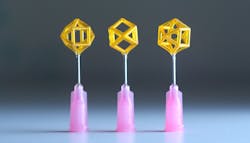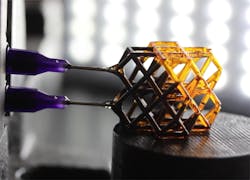Newly Developed Metamaterials Change Mechanical Properties Under Magnetic Fields
A team of researchers at Lawrence Livermore National Laboratory (LLNL) has created a new class of metamaterials that can be put inside 3D printed structures and nearly instantly (less than a second) respond and stiffen when exposed to a magnetic field—a development that could be applied to next-generation protective gear and a host of other innovations.
The so-called “field-responsive mechanical metamaterials” (FRMMs) use a viscous, magnetically responsive fluid that is manually injected into the hollow struts and beams of 3D-printed lattices. Unlike other shape-morphing—or “4D-printed”—materials (the fourth dimension being time), the overall structure of the FRMMs does not change. The fluid’s ferromagnetic particles inside the part form chains in response to the magnetic field and stiffens the fluid and the lattice structure as a result.
“Metamaterials can create mechanical properties that sometimes don’t exist in nature or can be highly designed, but once you build the structure you’re stuck with those properties,” says LLNL engineer Julie Jackson Mancini. “The next evolution of these metamaterials is something that can adapt its mechanical properties in response to an external stimulus. They exist, but they respond by changing shape or color and the time it takes to get a response can be on the order of minutes or hours.
“With FRMMs, the overall form doesn’t change,” Mancini continues. “The stiffness does, and the response is quick, which sets it apart from these other materials.”
Researchers injected a magnetorheological (MR) fluid into a hollow lattice structures 3D printed on LLNL’s Large Area Projection Microstereolithography (LAPµSL) platform. It creates objects with microscale features over wide areas using light and a photosensitive polymer resin.
Researchers injected a magnetorheological fluid into a hollow lattice structure which was 3D printed on LLNL’s Large Area Projection Microstereolithography platform. This platform can create objects with microscale features over wide areas using light and a photosensitive polymer resin.
The new dynamically tunable metamaterial owes a lot of its success to the LAPµSL machine, according to Mancin, because the complex tubular lattice structures had to be manufactured with thin walls relative to the overall size of the structure. The structure also had to be able to keep the fluid contained while withstanding the pressure generated during the filling process and the material’s responses to magnetic fields.
Once the fluid is inside the lattice structures, applying an external magnetic field causes the fluid to stiffen; the overall 3D-printed structures subsequently stiffen almost instantaneously. The change is easily reversible and highly tunable by varying the strength of the magnetic field.
“What’s important is that it’s not just an on-and-off response,” Mancini says. “Adjusting the strength of the magnetic field elicits a wide range of mechanical properties. The idea of on-the-fly, remote tunability opens the door to a lot of applications.”
Mancini notes that the technology could be useful for lessening the force of impacts. Automotive seats, for example, could have responsive metamaterials inside along with sensors to detect a crash. The seats would stiffen on impact, potentially reducing passenger motion and injuries. The technology could also be applied to next-generation helmets or neck braces, housings for optical components, and soft robotics, among many other applications.
To predict how arbitrary MR fluid-filled structures would respond to a magnetic field, the team developed a model based on tests done on a single strut. The researchers used the model to improve lattice topologies, finding structures that would go through large changes in mechanical properties as the magnetic field is varied.
Researchers will now try to develop a single-phase material that can be used to 3D print objects that change properties in response to some stimulus, instead of having to inject a liquid inside the hollow parts. One approach is to incorporate the magnetic-responsive fluid inside the printing material and making it solidify.


